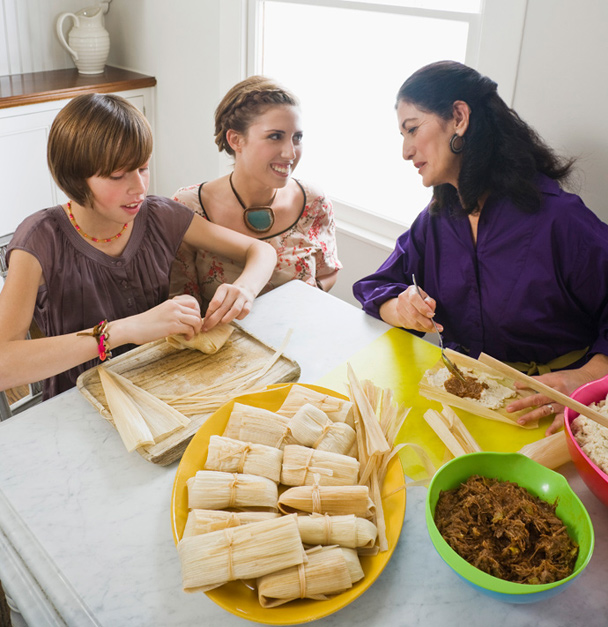Every year in late October preparations begin in homes and businesses throughout Mexico for El Día de los Muertos, or the Day of the Dead. While Americans are abuzz over Halloween costumes and dunking for apples, Mexican families are busy planning festivities dedicated to remembering those who have passed.
Neither a somber nor mournful occasion, the national holiday is a celebration that typically takes place over a two-day period. On November 1, the souls of all deceased children are remembered, and on November 2, a day that coincides with the Christian holiday of All Souls’ Day, those who have passed are invited back into their homes to celebrate with their living relatives.
Since pre-Columbian times, Mexicans have believed the souls of the dead are at rest and waiting to return home to be among the living. The ceremonial holiday begins with the Vigil of the Little Angels, which is an observance of the deceased children’s souls, and features homemade altars draped in white linens and piled high with flowers and candles. It’s said this tradition is most beautifully honored on the tiny island of Janitzio in the middle of Lake Pátzcuaro, in the central state of Michoacán.
Throughout the country, altars dedicated to deceased children or adults become colorful displays showcasing sugar skulls, breads baked in the shape of bones, beer, tequila, and even packs of cigarettes—all intended to make the spirits feel welcome and comfortable. The shrines appear not only in homes but also in churches, restaurants, and shops across Mexico. Family members participate in candlelit vigils in cemeteries, where graves are tidied up and decorated with candles and heaps of marigolds and ruby-red cockscomb.
The evening is spent awaiting the return of their dearly departed. It truly is a celebration—and one in which death and the devil are mocked rather than feared. Food is enjoyed, tequila and mezcal (a distilled alcoholic beverage made from agave) are drunk, and songs are sung. But a celebration of such scale begs for more than everyday fare. And in fact, the making of tamales, a popular Mexican party food, becomes an event in and of itself.
Making tamales is an incredibly labor-intensive process, so much so that since ancient times, Mexicans (and now Mexican-Americans) have realized the chore is best accomplished in groups. And thus the tamalada was born.
A tamalada is the tamale-making pre-party that takes place prior to a holiday or other special occasion. The gatherings allow family and friends to spend time together while simultaneously churning out dozens upon dozens of tamales. Those who participate in the tamalada are known as tamaleras, with each person assigned a specific task, such as cooking the variety of meat and vegetable fillings or preparing the corn husk wrappers for packaging. Because tamales are individually wrapped, they stay warm for hours in the vessel in which they were steamed, making them the ideal party food to tote to cemeteries on a fall night.
Tamales are defined as a sweet or savory food made with masa (a dough that is typically corn-based), wrapped in a leaf and steamed. They can be small finger-friendly snacks, or a more substantial knife-and-fork dish. Regardless of their size, the basic ingredients for all tamales are derived from a process known as nixtamalization (note the inclusion of the word tamal), which dates back to 1000 B.C.
Nixtamalization involves soaking dried maize (corn) in an alkaline solution of water and lime or ash. This improves the flavor of the corn, but more important, increases its nutritional value by providing niacin, an essential B vitamin not otherwise obtained from dried corn. The process likely originated when ash from the bottom of the cooking vessel was added into the simmering corn.
Tamales in Mexico are usually wrapped in dried corn husks—an abundant by-product in this nation where corn is king—but plantain leaves might also be used, as well as banana leaves, particularly in tropical regions like the Yucatán. The base of the tamales consists of masa mixed with lard or vegetable shortening. Freshly rendered lard produces the best taste and texture, as the solid fat is beaten until quite light then combined with additional masa until the right consistency is achieved. The goal is a light, airy mixture, which I test for by dropping a spoonful into a glass of water to ensure that it floats. Stock is then added to the mixture until it becomes the consistency of thick pancake batter, and then it is set aside to rest so the masa can absorb all of the liquid.
Plain tamales—simply the prepared masa, with no filling—are often enjoyed for breakfast. But plain will not suffice for a celebration as grand as the Day of the Dead, and so the tamales are filled with every variety of chicken, pork, red or green chile sauce, or mole. Sweet tamales are often tinted pink with red food coloring and filled with raisins or other fruit.
Whether you’re celebrating Halloween or the Day of the Dead this fall, gather your friends, family, and favorite ingredients and create your own custom fillings using this basic cornmeal tamale recipe or opt for the traditional tastes of rajas (roasted peppers with onions and herbs) or a grilled variety filled with poblanos and fresh corn. Regardless of what flavor you choose, celebrate the living and remember the dead with the ultimate tamale-making fiesta.
Daniel Stone is the recipe editor and recreational class instructor at the Institute of Culinary Education (ICE) in New York City. In addition to teaching at both ICE and Whole Foods, Stone has worked as a food stylist for Saveur, the History Channel, and the Food Network.



 Pinterest
Pinterest


